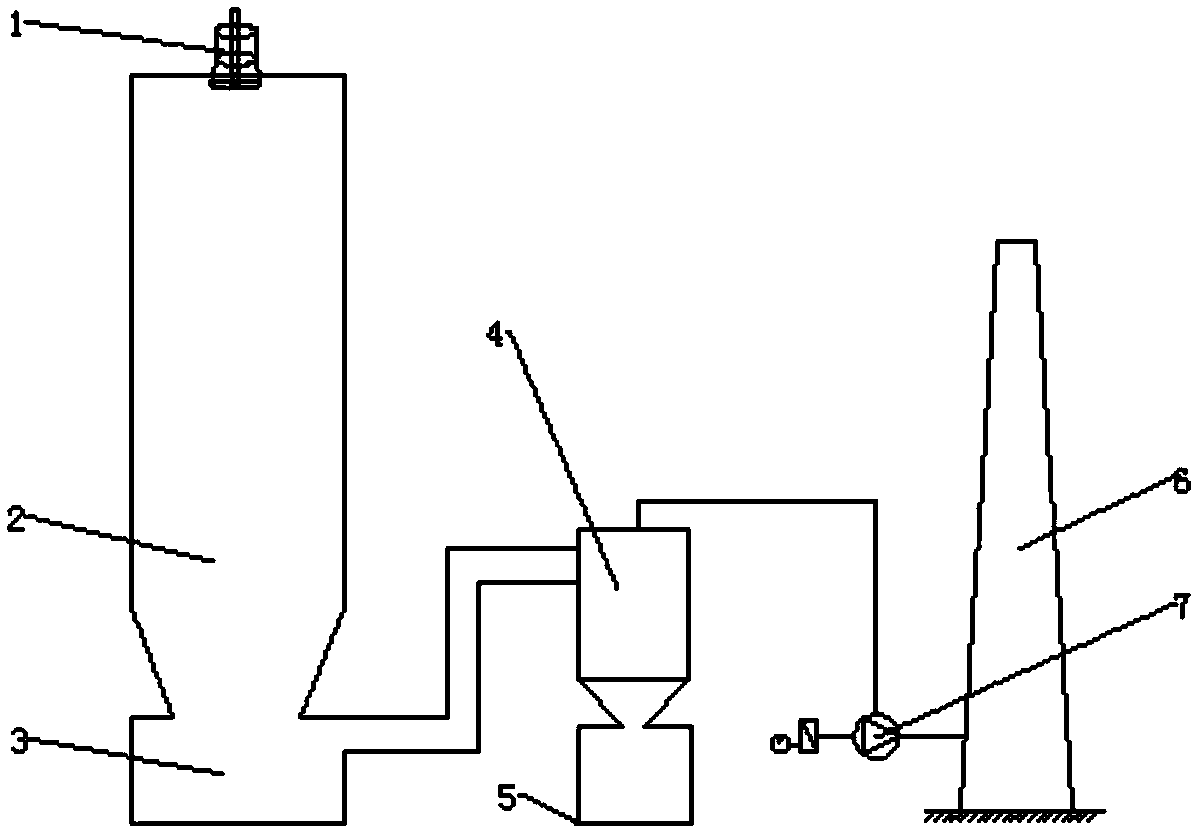Method for flash oxygen-enriched roasting of neodymium iron boron waste
An oxygen-enriched roasting and neodymium-iron-boron technology, which is applied in the direction of improving process efficiency, can solve the problems of large external heat dissipation area, slow reaction rate, and large volume, and achieve reduced energy consumption, easy atmosphere, and good sealing of the furnace body Effect
- Summary
- Abstract
- Description
- Claims
- Application Information
AI Technical Summary
Problems solved by technology
Method used
Image
Examples
Embodiment 1
[0013] Spray the powdery NdFeB waste with a particle size of 100 mesh and oxygen-enriched air with an oxygen mass percentage concentration of 40% into a reaction tower (2) with a height of 2.5 meters and a temperature of 800 °C through a nozzle (1). In a highly dispersed floating state, it falls from the upper end of the reaction tower to the lower end. During this process, the iron and rare earth in the material are rapidly oxidized by oxygen-enriched air. The oxidation rate of iron in the waste is 99.41%, and the oxidation rate of rare earth is 99.82%. Oxidation products fall into the collector (3) below the reaction tower, and the flue gas enters the cyclone dust collector (4) through the upper outlet of the collector (3) to collect dust, and the dust obtained falls into the collector (5). The upper end of the dust collector is sucked into the chimney (6) by the induced draft fan (7) and then emptied.
Embodiment 2
[0015] Spray the powdery NdFeB waste with a particle size of 200 mesh and oxygen-enriched air with an oxygen mass percentage concentration of 30% into a reaction tower (2) with a height of 3.5 meters and a temperature of 1000 °C through a nozzle (1). In a highly dispersed floating state, it falls from the upper end of the reaction tower to the lower end. During this process, the iron and rare earth in the material are rapidly oxidized by oxygen-enriched air. The oxidation rate of iron in the waste is 99.85%, and the oxidation rate of rare earth is 99.94%. Oxidation products fall into the collector (3) below the reaction tower, and the flue gas enters the cyclone dust collector (4) through the upper outlet of the collector (3) to collect dust, and the dust obtained falls into the collector (5). The upper end of the dust collector is sucked into the chimney (6) by the induced draft fan (7) and then emptied.
Embodiment 3
[0017] Spray the powdery NdFeB waste with a particle size of 300 mesh and oxygen-enriched air with an oxygen mass percentage concentration of 50% into a reaction tower (2) with a height of 2.5 meters and a temperature of 900 °C through a nozzle (1). In a highly dispersed floating state, it falls from the upper end of the reaction tower to the lower end. During this process, the iron and rare earth in the material are rapidly oxidized by the oxygen-enriched air. The oxidation rate of iron in the waste is 99.75%, and the oxidation rate of rare earth is 99.91%. Oxidation products fall into the collector (3) below the reaction tower, and the flue gas enters the cyclone dust collector (4) through the upper outlet of the collector (3) to collect dust, and the dust obtained falls into the collector (5). The upper end of the dust collector is sucked into the chimney (6) by the induced draft fan (7) and then emptied.
PUM
| Property | Measurement | Unit |
|---|---|---|
| particle size | aaaaa | aaaaa |
Abstract
Description
Claims
Application Information
 Login to View More
Login to View More - R&D
- Intellectual Property
- Life Sciences
- Materials
- Tech Scout
- Unparalleled Data Quality
- Higher Quality Content
- 60% Fewer Hallucinations
Browse by: Latest US Patents, China's latest patents, Technical Efficacy Thesaurus, Application Domain, Technology Topic, Popular Technical Reports.
© 2025 PatSnap. All rights reserved.Legal|Privacy policy|Modern Slavery Act Transparency Statement|Sitemap|About US| Contact US: help@patsnap.com

